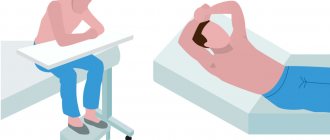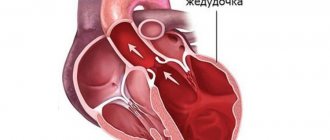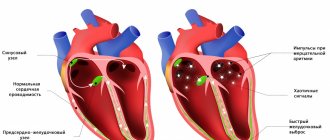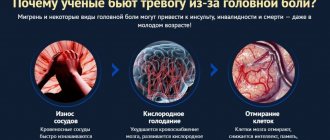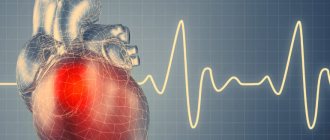What is intercostal neuralgia?
Neuralgia of the intercostal nerves is pain of a different nature that occurs due to various etiological factors. It is more often observed in adult men and women over 30-35 years of age. Symptoms of neuralgia may appear suddenly on one or both sides of the chest, along one or more intercostal nerves. The disease has an ICD code - M.79.2.
To understand what intercostal neuralgia is, you should understand the anatomical features of the thoracic nerves. There are 12 pairs in total. Each intercostal nerve contains motor, sensory and sympathetic fibers. It originates from the anterior roots of the spinal cord of the thoracic spine, passes along the lower edge of each rib, reaching the sternum. The parietal pleura covers the nerve fibers on top.
Thoracic nerves transmit impulses to the skin, the musculo-ligamentous apparatus of the chest and the anterior wall of the abdomen, partly the pleura and peritoneum, and the mammary glands. Sensitive fibers of neighboring nerve trunks actively interact with each other, creating cross innervation.
How to distinguish intercostal neuralgia from heart disease?
If neuralgia has acute symptoms in the thoracic region on the left side, differential diagnosis with heart disease must be carried out. You should not look for the cause of the pain syndrome on your own. Thoracalgia on the left side should always be a reason to consult a doctor.
Heart pain and symptoms of intercostal neuralgia on the left have distinctive features:
| Intercostal acute neuralgia on the left: typical symptoms | Cardiovascular diseases: characteristic manifestations |
| The pain intensifies with forced breathing, coughing, sneezing, laughing, physical exertion and movement, but does not change with fast walking and excitement. | The pain does not change its intensity with a deep breath or muscle tension, but intensifies with cardio exercise (fast walking, running, climbing stairs). |
| Chest neuralgia is not relieved by taking nitroglycerin | With angina pectoris, the pain attack goes away within 3-5 minutes after using nitroglycerin. With myocardial infarction, severe pain cannot be relieved with medications. In this case, you should immediately call an ambulance. |
| Normal pulse and blood pressure are determined | Changes in heart rate and blood pressure |
| Pain increases with palpation of the ribs and spaces between them | The intensity of pain does not change when palpating the intercostal spaces |
| Painful symptoms on the left “go” along the nerve or are encircling in nature | Pain is localized behind the sternum or in the projection of the heart |
Symptoms of intercostal neuralgia on the left and right should also be differentiated from other diseases (pleurisy, pneumonia, thoracic aortic aneurysm, pericarditis, acute pancreatitis and others). If there is severe pain in the chest, only a doctor can determine exactly what it is - neuralgia or another pathology.
Causes of intercostal neuralgia and risk factors
Intercostal neuralgia can develop for a variety of reasons. Among them are:
- injuries to the thoracic nerves, chest and spine;
- surgical interventions, long-term immobilization of a person in a certain position;
- poisoning with chemicals, prolonged use of medications;
- congenital developmental anomalies, hereditary diseases;
- infectious processes (shingles, tuberculosis, brucellosis and others);
- some neurological diseases, such as radiculitis and multiple sclerosis;
- diseases of the spine (osteochondrosis, deforming spondylosis, herniated intervertebral discs);
- compression of nerve branches in the bone-connective sheaths, for example, in the presence of scar changes, benign or malignant neoplasms;
- immunodeficiency (HIV infection, cancer, etc.);
- allergic reactions;
- diabetes;
- various metabolic disorders in nervous tissue and its hypoxia;
- lack of B vitamins in the body;
- alcohol abuse;
- osteoporosis;
- pathology of nearby anatomical structures (aorta, lungs, pleura);
- various systemic diseases (atherosclerosis, rheumatism, anemia, thyrotoxicosis, etc.).
More often, chest neuralgia appears due to several causes. Therefore, it is typical for older patients with vascular, degenerative and metabolic disorders. Sometimes symptoms of neuralgia appear after excessive physical activity, sudden movements or prolonged stay in one position. They can also occur after hypothermia or severe stress.
More often, intercostal neuralgia is observed on the left or right; less often, there is a bilateral lesion. In most cases, the pathogenesis is based on muscle spasm, leading to compression of nerve fibers. Pain occurs in response to nerve damage.
In children, signs of intercostal neuralgia are rare. When they appear, parents should definitely show the child to the doctor, as this may be a signal of the presence of a serious pathology. The doctor will determine the possible causes and explain how to cure intercostal neuralgia in this case.
Causes of pain in the neck and between the shoulder blades
There are many possible reasons why your back hurts between your shoulder blades and your neck. This symptom may be evidence of:
- injuries;
- osteochondrosis, kyphosis or scoliosis (curvature of the spinal column);
- spondyloarthrosis;
- hernias;
- neuralgia;
- infectious diseases;
- diseases of the cardiovascular system;
- pathologies of the digestive system;
- kidney diseases;
- side processes in systemic diseases.
It is worth taking a closer look at the most common causes of pain in the shoulder blades and neck to determine why the discomfort occurred.
Osteochondrosis and osteoarthrosis
Often there is pain under the left shoulder blade and neck when osteochondrosis worsens. This condition is a process of destruction and thinning of the cartilage tissue between the vertebrae, which leads to a decrease in the distance between them, pinched nerves and severe pain. Osteoarthritis often occurs as a complication of osteochondrosis, when the neck hurts not only because the elasticity of the cartilage decreases, but also because degenerative processes occur in the joints of the spinal column. Both diseases, as a rule, appear at the age of 40 years, when the body no longer renews itself properly.
Damage
Often the back hurts in the neck and shoulder blades when a person hits, falls or makes a sudden movement leading to damage to ligaments, muscles or joints. If you have been injured and then have pain between your shoulder blades and neck, you should contact a traumatologist as soon as possible, who will determine the cause of the condition and prescribe treatment. A neck injury is a very serious incident, so do not underestimate the possible consequences.
Forms of the disease
Chest neuralgia can be primary (an independent pathology) and secondary (a symptom of another disease). There are also radicular and reflex forms of the disease. In the first case, symptoms of intercostal neuralgia on the left and right arise due to irritation of the spinal roots. The second type of pathology occurs due to a negative effect on peripheral receptors.
In addition, clinicians distinguish the following types of thoracic neuralgia:
- musculoskeletal;
- vertebrogenic;
- spicy;
- chronic;
- right-sided;
- left-handed;
- psychogenic;
- during pregnancy.
Intercostal neuralgia of a certain type has its own characteristic symptoms and treatment features.
Treatment
Help before diagnosis
Most non-drug measures are aimed at preventing pain between the shoulder blades: developing and maintaining correct posture, eating a balanced diet without harmful foods, leading an active lifestyle and playing sports. In case of severe pain during the diagnostic search, the doctor prescribes non-narcotic analgesics, recommends limiting mobility, and, if necessary, prescribes strict bed rest.
Conservative therapy
In the treatment of back pain between the shoulder blades, a differentiated approach is used - the therapeutic regimen is selected individually, taking into account the leading disease that caused the symptoms and concomitant pathologies. In case of orthopedic problems, posture correction with the help of corsets and other orthoses comes to the fore. The following groups of medications are used to treat the causes of pain:
- Nonsteroidal anti-inflammatory drugs
. Prescribed to relieve discomfort in diseases of the osteoarticular system, as well as to eliminate inflammation and speed up recovery. NSAIDs are also effective for diseases of the respiratory organs and mediastinitis. - Antisecretory drugs
. Proton pump inhibitors and H2-histamine blockers are the basis for the treatment of GERD and achalasia cardia. The drugs reduce damage to the esophagus from acidic stomach contents and relieve pain. To quickly relieve the burning sensation, non-absorbable antacids are taken. - Antibiotics
. Massive antimicrobial therapy is indicated for acute forms of mediastinitis to destroy pathogens and prevent bacterial complications. Medicines are selected empirically. A combination of 2-3 agents is introduced to act on all possible types of microbes. - Cytostatics
. Polychemotherapy is selected for some forms of mediastinal cancer as preparation for surgery or as palliative care. Immunosuppressants are sometimes recommended for patients with severe forms of ankylosing spondylitis.
Patients with acute conditions (aortic dissection, fulminant mediastinitis) are hospitalized in the intensive care unit. The goal of treatment is to get rid of the state of shock: for this purpose, cardiotropic medications, infusion solutions are used, and oxygen support is provided. To relieve pain, narcotic analgesics and tranquilizers are administered.
Non-drug methods play an important role in the treatment of musculoskeletal diseases. Special exercise therapy complexes are prescribed to strengthen the muscle corset and form an even posture. Manual manipulation, kinesiotherapy, orthopedic massage of the chest, back, and lower back show good results. A number of physiotherapeutic methods are used: electrical stimulation of the back muscles, peloid therapy, general ultraviolet radiation.
Surgery
For persistent deformities of the spinal column, surgical correction of scoliosis is recommended. Surgical treatment for osteochondrosis is resorted to in the case of spinal compression: the intervertebral hernia is removed and the spinal canal is decompressed. As a rule, minimally invasive techniques are used: puncture vaporization of the disc, microdiscectomy.
Surgical interventions are indicated for complicated forms of diaphragmatic hernia and severe stenosis of the esophagus. The hernial orifice is sutured with crurorrhaphy, gastropexy or fundoplication, resection and plasty of the esophagus. Emergency surgery is the only treatment for a dissecting aneurysm. Vascular surgeons perform resection of the damaged area with reconstruction of the aorta.
Symptoms of neuralgia on the right and left
Any neuralgia, including intercostal neuralgia, is primarily pain. Painful sensations can be of a different nature (aching, dull, sharp, piercing, burning) and have different intensity. Sometimes the pain is so severe that it forces a person to take a forced position and sharply limit physical activity. Intercostal neuralgia, which has pronounced symptoms, is described by patients as a lumbago or electric current discharge running from the spine to the sternum.
Thoracalgia often begins gradually, with a tingling sensation in the intercostal spaces, then acquires pronounced intensity. Less often it occurs suddenly. The pain can radiate to the scapula, epigastric area, heart, arm and lower back. Sometimes it takes on an encircling character. It intensifies with changes in body position, movements, coughing and deep breathing.
As a rule, painful attacks are constantly repeated, lasting from a few seconds to 2-3 minutes. Therefore, treatment of acute intercostal neuralgia on the right and left, first of all, always begins with the elimination of pain.
In addition to thoracalgia, a person may be bothered by characteristic local signs caused by the influence of sympathetic, sensory and motor nerve fibers. Intercostal neuralgia, depending on the damage to a particular nerve, will have characteristic symptoms on the right, left or both sides of the chest:
- impaired sensitivity, crawling sensation, numbness, tingling;
- muscle twitching;
- increased sweating;
- change in skin color.
If chest neuralgia appears against the background of a herpes infection, it may be accompanied by skin rashes. The latter appear 2-4 days after the onset of thoracalgia. Elements of the rash are located on the skin of the intercostal space in the form of small pink spots, which then turn into vesicles and then into crusts. Subsequently, traces of pigmentation may remain on the skin.
Diagnosis of intercostal neuralgia
Make an appointment Shpigel Anna Yakovlevna Neurologist, massage therapist 33 years of experience. The specialist receives: - newborn children and schoolchildren - adults - athletes Reviews from patients Consultation from 3000 rubles.
Acute intercostal neuralgia is a reason to contact a competent, qualified neurologist. Since symptoms in adults with damage to the thoracic nerves can be disguised as other diseases, the patient must undergo a comprehensive examination to exclude possible pathology. The doctor must conduct a survey and examination.
The person’s posture is noteworthy when he leans towards the healthy side, so as not to provoke a painful attack. Palpation of the chest reveals pain. Trigger points are identified at the lower edge of the rib, where the affected nerve passes. If neuralgia affects several nerve branches, which often happens, this leads to a decrease or complete loss of sensitivity in the corresponding area of the body.
First of all, the doctor must distinguish the symptoms of intercostal neuralgia on the left from cardiovascular pathology. For this purpose, the patient undergoes an ECG. If indicated, a cardiologist is consulted. In order to correctly diagnose and treat intercostal neuralgia, the doctor also excludes diseases of the respiratory system, digestive tract, musculoskeletal system, infectious processes and other diseases. He may prescribe a number of additional tests (laboratory tests, x-ray of the lungs, ultrasound of the abdominal organs, MRI of the spine, etc.).
Thoracic neuralgia is an indication for electroneurography. This method allows you to determine the condition of nerve fibers by assessing their structure and functionality.
Chest neuralgia can be a manifestation of benign and malignant tumors. It is often the first symptom of a herniated disc and degenerative changes in the spine. Therefore, early identification of its causes is considered an important task for the neurologist and the patient.
Diagnostic measures
Our specialists will make a more precise diagnosis after carrying out the necessary laboratory and instrumental diagnostics using the most modern equipment. When indicated, the following will be carried out:
- blood tests;
- urine test to evaluate kidney function;
- performing liver function tests;
- gastric endoscopy;
- Ultrasound for diagnosing somatic disorders, cardiac and vascular conditions;
- CT scan of the liver, pancreas;
- ECG of the heart;
- X-ray of the sternum.
Based on the fact that pain under the left shoulder blade from the back may not be a symptom of a single disease, a comprehensive examination by several specialists is not excluded. Our clinic offers patients one of the modern comprehensive types of examination - check-up, which includes many types of tests with the smallest set of diagnostic procedures. Timely contact with our specialists and a guaranteed correct diagnosis will help the patient undergo high-quality and successful treatment.
How to treat intercostal neuralgia?
Treatment of any neuralgia, including intercostal neuralgia, is aimed at eliminating the clinical manifestations and causes of the disease. Therapy includes a whole range of activities. If a patient is diagnosed with neuralgia, you can find out how to treat it from the specialists of our clinic. The doctor will select the optimal therapeutic course, taking into account the characteristics of the disease and the individual characteristics of the person.
As a rule, intercostal neuralgia requires long-term treatment and further measures to prevent painful attacks. The doctor prescribes specific methods of therapy, determines the duration of each course, and gives his recommendations on lifestyle and regimen. The treatment plan may include:
- painkillers;
- etiotropic therapy aimed at combating the underlying disease;
- anti-inflammatory drugs;
- neurotropic drugs;
- physiotherapy;
- osteopathy;
- massage;
- Exercise therapy.
The doctor always chooses how to treat neuralgia, based on the clinical picture, the stage of the process, the results of diagnostic examinations and the individual characteristics of the patient.
Is osteopathy effective for intercostal neuralgia?
The causes of neuralgia in the rib area can be different. However, in many cases, a pinched nerve is caused by the consequences of various injuries a person has received in the past. The capabilities of fine diagnostics using hands make it possible to identify and eliminate these disorders, which leads to the elimination of compression of the nerve and the restoration of its normal blood supply. As a result, inflammation and its integral companion – pain – go away. Osteopathy shows high effectiveness in the treatment of both unilateral and bilateral intercostal neuralgia.
Possible complications and consequences
Any neuralgia, in particular intercostal neuralgia, that does not respond to treatment, may be a sign of a serious illness. Most of the complications that arise with thoracalgia are precisely a manifestation of the underlying pathology, which worsens against the background of constant pain.
Chest neuralgia itself, with a long-term severe course, can provoke the development of a hypertensive crisis or an attack of angina (less often, myocardial infarction). Severe, constant pain affects a person’s physical and mental state in different ways. Often severe symptoms of intercostal neuralgia on the left or right significantly complicate the patient’s life. He sleeps poorly, is nervous, cannot move normally and do his usual work.
Pain in the intercostal spaces does not allow the patient to perform full breathing movements, which leads to a decrease in oxygen supply to the body and the development of hypoxia. Sometimes neuralgia is accompanied by such debilitating pain that it contributes to emotional exhaustion, and this is a serious complication, since this condition causes depression.
Factors contributing to pain between the shoulder blades
Painful sensations in the interscapular area can occur against the background of some vertebral pathologies:
- osteochondrosis of the thoracic region;
- problems with posture (kyphosis, scoliosis, kyphoscoliosis);
- spondyloarthrosis;
- humeroscapular periarthrosis;
- protrusion and intervertebral hernia in the thoracic region;
- intercostal neuralgia;
- radiculitis;
- spinal column injuries.
Problems in the functions of the spine can develop:
- during sedentary work;
- in the absence of sports;
- under significant loads for which the body is not ready.
More than one spine may be the source of the problem. Painful manifestations may occur against the background of disturbances in the functioning of internal organs. For example, the presence of cardiac pathologies: angina pectoris, coronary artery disease.
In addition, pain syndrome can develop against the background of:
- hepatitis A;
- cholecystitis;
- peptic ulcer in the stomach;
- pulmonary diseases;
- infectious pathologies.
Often, people who move little due to the specific nature of their work activity have to face a similar problem, since their muscular and ligamentous systems are weakened, and the muscle fibers in the shoulder girdle are tense for a long time. Such pain often bothers drivers, garment factory workers, etc.
Neuralgia during pregnancy
If intercostal neuralgia appears in a pregnant woman, how to diagnose it and how to treat it is decided by a neurologist together with a gynecologist. Therapy is selected taking into account possible negative effects on the fetus. Self-medication in this situation is considered unacceptable, as this can have a negative impact on the health of the expectant mother and child.
To prevent chest neuralgia from appearing during pregnancy, it is advisable to follow preventive measures. If a woman has previously had attacks of thoracalgia, then at the stage of preconception preparation she should visit a neurologist and osteopath. The doctor will conduct a diagnosis, and then the neurologist will give a number of recommendations on how to treat intercostal neuralgia. An osteopath will identify possible causes of neuralgia and conduct a treatment session aimed at eliminating them.
Effective therapeutic techniques
After determining the root cause of interscapular pain, the patient may need to consult with a cardiologist, neurologist, or gastroenterologist. Until you receive medical help, you can try to relieve the pain syndrome on your own; you should not endure it for long. There are some harmless methods to relieve pain.
Gymnastic exercises
A gymnastics complex will help relieve discomfort:
- We place our palms on our shoulders and perform several circular movements back and forth.
- We raise our palms to the top, then our arms completely, lock them together, lower our heads, and concentrate our gaze on the fingers.
- We bring and spread the shoulder blades.
- We perform body turns alternately to the right and left.
Medicines
Taking medications without medical advice is contraindicated, as this may worsen the situation.
In cases where the cause of pain in the intervertebral region is associated with spinal diseases, the doctor may prescribe treatment with drugs from the NSAID group:
- Diclofenac;
- Indomethacin;
- Movalis;
- Ibuprofen;
- Nimesulide;
- Meloxicam;
- Naproxen;
- Voltaren, etc.
As an auxiliary therapy, the affected area can be treated with external agents: Fastum gel, Capsicam, Amelotex, Nise gel.
After the pain has eased, you can resort to local medications with an irritating effect:
- Efkamena;
- Menovazina;
- Finalgona.
Forecast and prevention of intercostal neuralgia
In most patients, intercostal neuralgia can be completely cured. If thoracalgia occurs against the background of a herpetic infection, relapses are possible.
If adequate treatment of neuralgia does not bring the desired result, a more “deep” diagnosis is carried out to search for the possible cause of this condition. First of all, spinal hernias, benign and malignant tumors are excluded.
To prevent neuralgia of the intercostal branches from recurring, and its symptoms in adults to manifest themselves less painfully, doctors recommend the following preventive measures:
- follow the canons of a healthy lifestyle: give the body adequate physical activity, eat right, actively relax in the fresh air, give up bad habits, etc.;
- maintain normal functioning of the immune system;
- monitor posture and spinal health;
- promptly treat chronic diseases and infectious processes;
- if possible, visit the pool and harden yourself;
- undergo preventive examinations on time;
- undergo regular scheduled examinations by an osteopath approximately once every six months.
If a person has previously had thoracic neuralgia, he should not be overcooled, be in a draft, expose the body to excessive physical stress, perform sudden movements or remain in an uncomfortable position for a long time. In addition, it is necessary to eliminate or minimize as much as possible stress and any unfavorable factors that can cause symptoms of intercostal neuralgia on the left, right or both sides.
Did you like the article? Add the site to your browser bookmarks
Adviсe
Since the cause of pain is often spinal diseases, in order to keep the spine healthy, it is recommended:
- try not to stay in one position for a long time;
- play sports (but in moderation);
- avoid hypothermia;
- ensure uniform load distribution;
- do not strain muscle tissue too much;
- ensure that your diet is balanced.
Pain in the interscapular area can indicate the development of many diseases. This can be either a disease of the spinal column or problems with internal organs. It is impossible to determine the source of the problem on your own. To do this, you need to consult a doctor, undergo an appropriate examination and begin treatment prescribed by the doctor.
